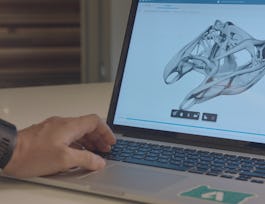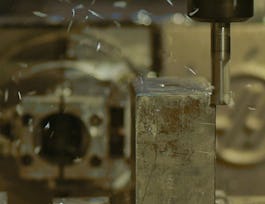Designing a product is only part of the process. Now, can that product be manufactured? In many cases the end product is made up of an assembly of different pieces to simplify manufacturing. With generative design and additive manufacturing, we can now take a different approach to the process of designing and producing complex products by ultimately reducing the number of parts and steps in an assembly while optimizing a design for strength and weight reduction.


Generative Design for Part Consolidation
This course is part of Autodesk Generative Design for Manufacturing Specialization
Taught in English
Some content may not be translated

Instructor: Autodesk
4,708 already enrolled
Included with 
Course
(62 reviews)
Recommended experience
What you'll learn
Inspect a multi-component assembly.
Identify manufacturing methods.
Practice how to reverse engineer for design intent.
Create a Generative Design Outcome.
Skills you'll gain
Details to know

Add to your LinkedIn profile
6 quizzes
Course
(62 reviews)
Recommended experience
See how employees at top companies are mastering in-demand skills

Build your subject-matter expertise
- Learn new concepts from industry experts
- Gain a foundational understanding of a subject or tool
- Develop job-relevant skills with hands-on projects
- Earn a shareable career certificate


Earn a career certificate
Add this credential to your LinkedIn profile, resume, or CV
Share it on social media and in your performance review

There are 4 modules in this course
In Week 1, we’ll cover the exploration of a complex design created as an assembly of multiple components to identify improvements and compile information to build a generative design.
What's included
19 videos9 readings2 quizzes2 discussion prompts
In Week 2, we’ll talk about setting up an unrestricted generative design study for multiple materials.
What's included
20 videos5 readings1 quiz1 discussion prompt
In Week 3, we’ll focus on the post process tools needed after a generative outcome is created. We focus on the tools and features needed to clean up a design to ultimately get it ready for production.
What's included
18 videos5 readings1 quiz1 discussion prompt
In Week 4, we’ll cover additional tools that benefit Generative Designs, but don’t apply to every case. We have covered a lot of information utilizing different workflows and use cases for Generative Design. Now we're going to focus additional energy to explore validation tools and some additional post processing tips.
What's included
20 videos5 readings2 quizzes1 peer review1 discussion prompt
Recommended if you're interested in Mechanical Engineering
Why people choose Coursera for their career




Learner reviews
Showing 3 of 62
62 reviews
- 5 stars
90.32%
- 4 stars
9.67%
- 3 stars
0%
- 2 stars
0%
- 1 star
0%

Open new doors with Coursera Plus
Unlimited access to 7,000+ world-class courses, hands-on projects, and job-ready certificate programs - all included in your subscription
Advance your career with an online degree
Earn a degree from world-class universities - 100% online
Join over 3,400 global companies that choose Coursera for Business
Upskill your employees to excel in the digital economy
Frequently asked questions
Yes! Autodesk also has Learning Pathways to start you on your learning journey, including certification prep courses and practice tests—so you feel confident when you take an Autodesk certification exam.
Yes, you’ll need to use all Autodesk® Fusion 360™ features for this course, including the generative design workspace and Autodesk cloud credits. The generative design workspace is only available to our professional subscription at this time. Be sure to review your access or payment options before enrolling.
The generative design workspace is only available to our professional subscription at this time.
If you're a student, consider enrolling in another Autodesk Specialization on Coursera.





